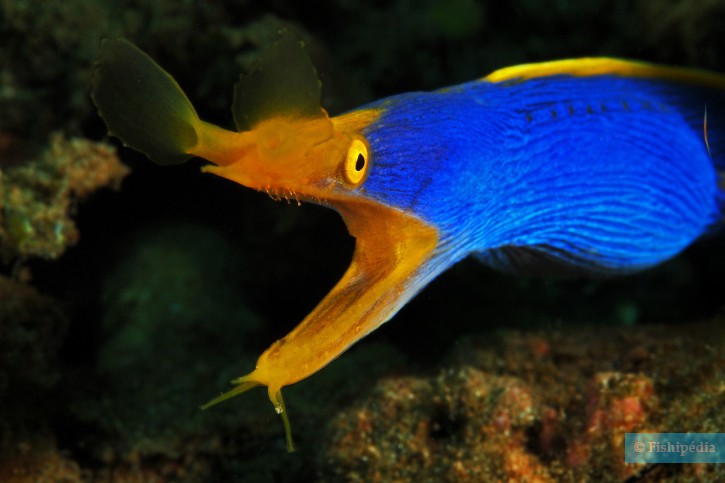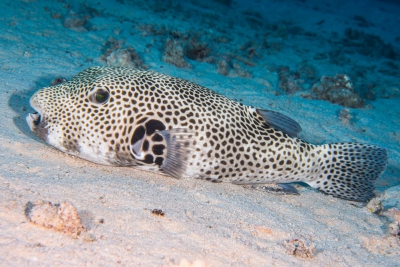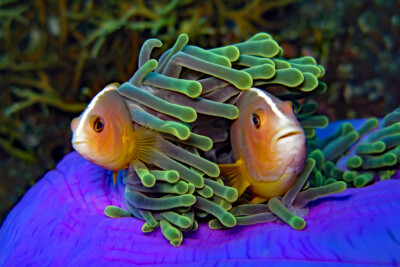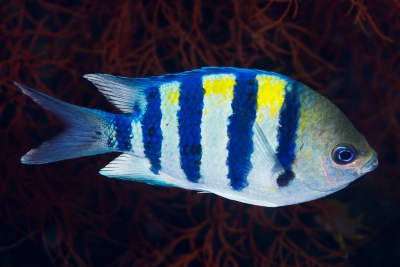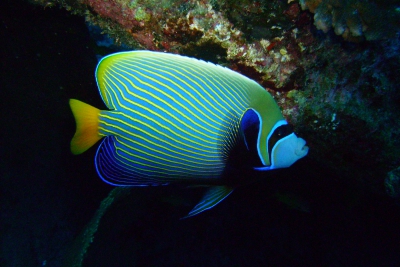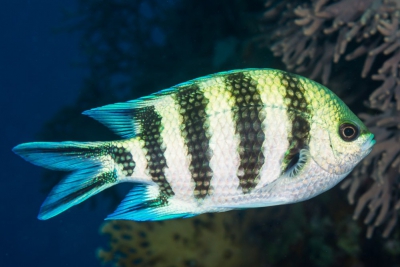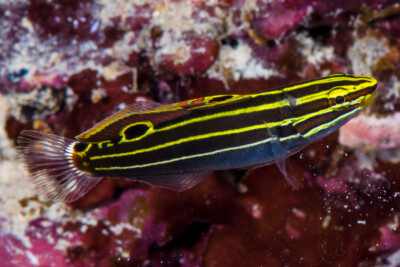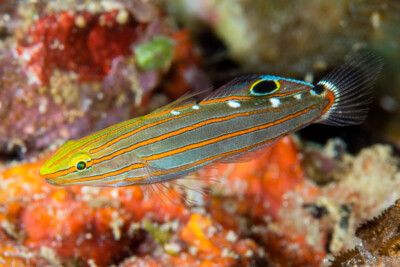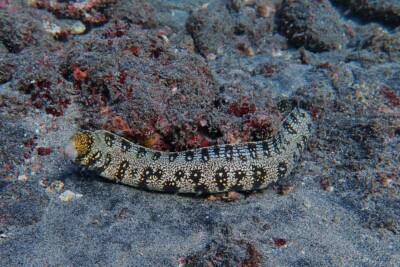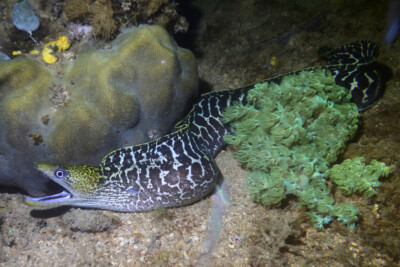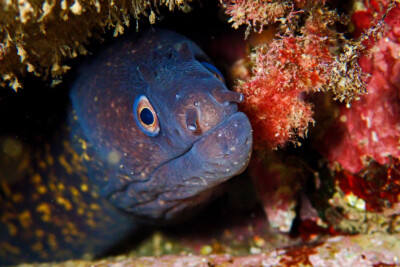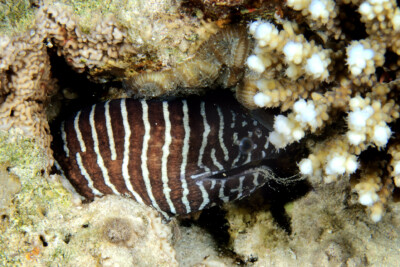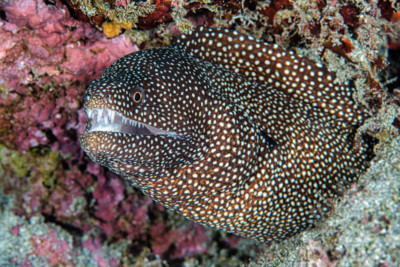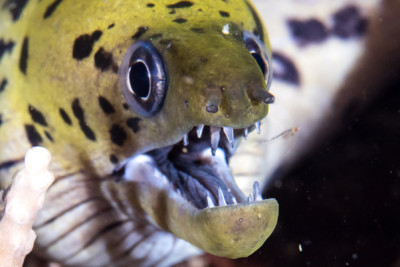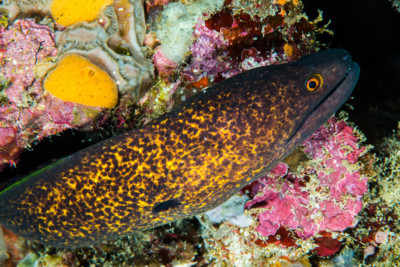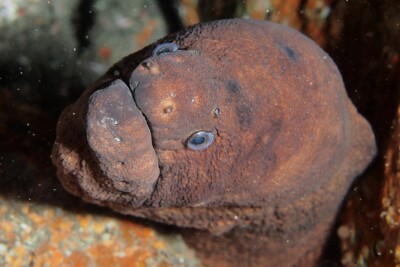ribbon moray
| Scientific name | Rhinomuraena quaesita |
|---|---|
| Descriptor | Garman |
| Year of description | 1888 |
| IUCN category (World) | LC |
| Family | Muraenidae |
| Genus | Rhinomuraena |
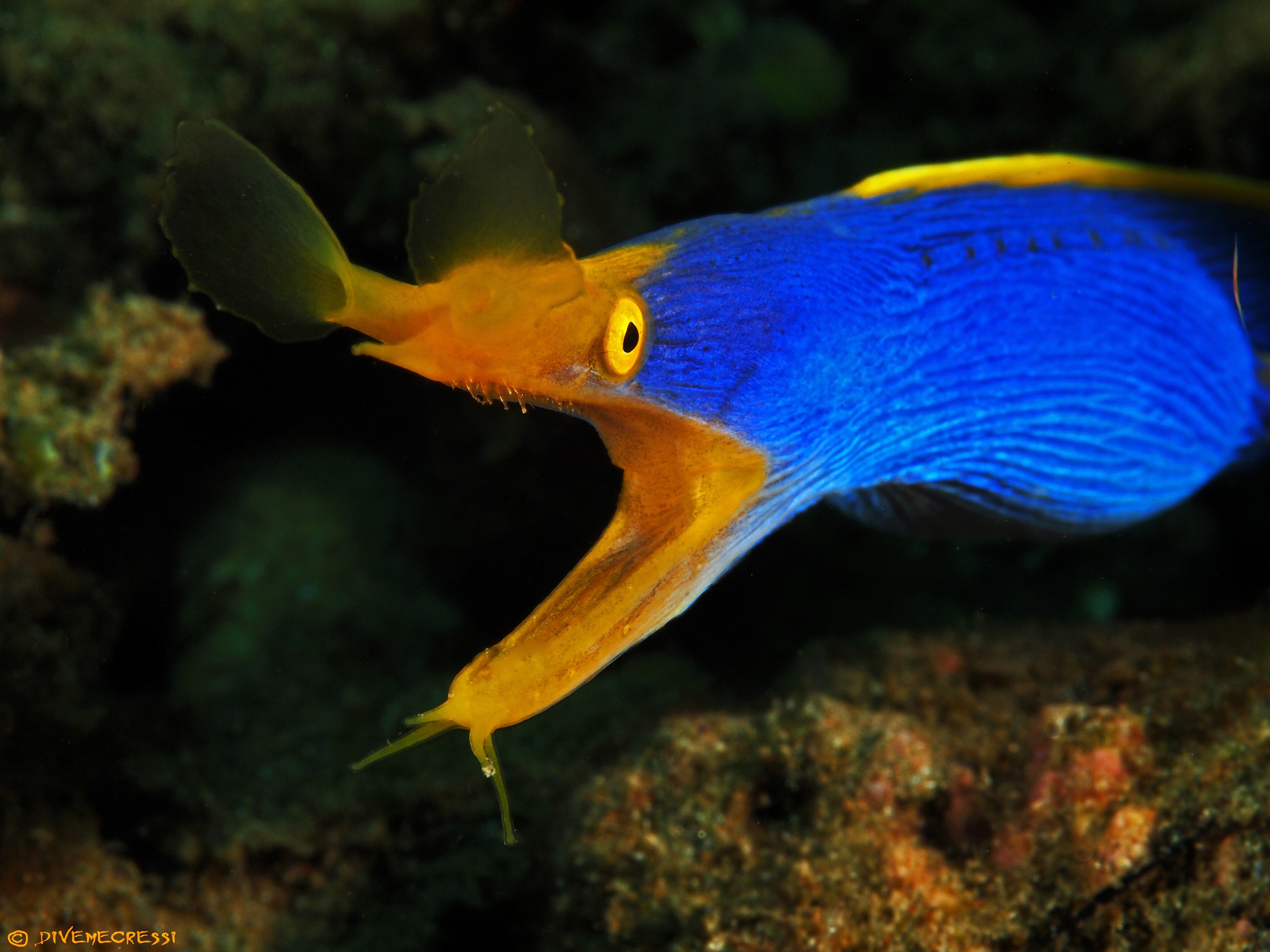

Introduction
Rhinomuraena quaesita, more commonly known as ribbon moray, is a tropical fish native to the Indonesian seas, the Indian Ocean, and the western tropical Pacific Ocean.
Who is it?
Morphology
-
Type
-
Average size100 cm
-
Maximum size120 cm
-
Type
-
Average size100 cm
-
Maximum size120 cm
How to recognize This fish ?
The ribbon moray is bicolored with a predominantly yellow and blue body. It is always born male. As they grow, individuals will change sex to become female, a phenomenon known as protandrous sequential hermaphroditism.
Sexual dimorphism
Behaviour & Life cycle
-
dietcarnivorous
-
Sociabilitysolitary
-
territorialNo
-
Way of livingnocturnal
The ribbon moray is a solitary fish that naturally resides on the bottom. It is a species with a calm temperament. Generally, it is an independent fish that pays little attention to other species.
The ribbon moray is a fish that primarily lives at night. Typically, it leaves its hiding spot and becomes active once dusk arrives.
The ribbon moray swims by making large undulations like a ribbon, a behavior that gave it its name.Reproduction
-
Reproductiondont le mode de reproduction est encore inconnu
-
Hermaphroditeprotandric
The ribbon moray is a fish whose mode of reproduction is still unknown.
Harmless species
This species does not represent any particular threats to humans when encountered in its natural environment.
Origin and distribution
What is its habitat?
Natural environment characteristics
-
Temperature24 - 28 °C
-
Depth1 - 50 m
-
FlowStrong
Biotope presentation
The ribbon moray is most commonly found at depths less than 50m. However, it is not impossible to find this fish at other depths. The bottom is usually made up of rocks.
Species of the same biotope
Main recommendations for fishkeeping
Deontology
In order to preserve wildlife, if you acquire this animal, it must not be released into the wild. See also, the Fishipedia charter.
Fishipedia supports the practice of responsible and environmentally friendly aquarium keeping. We encourage maintenance if it is motivated by a desire to understand the biological functioning of living things and if it is done with respect for animal life.
We believe that aquaristics is an opening to the discovery of aquatic environments, especially freshwater, and that this knowledge is necessary to better protect and respect these environments. Logically, we refute the compulsive purchase of animals that would not find a sufficient and / or adapted place in the host aquarium.
Our recommendationsThese tips apply to adult species from breeding. With regards to water conditions, wild species or close relatives must be kept under the same conditions as in their area of origin.
-
Min volume500 liters
-
Population minnot specified
-
Temperature24 - 28 °C
-
pH (acidity)8.2 - 8.4
CharacteristicsThe characteristics below apply for adult species. They correspond to an average of cases, validated in maintenance condition.
-
Difficulty breedingThe farming difficulty is relative. It depends on experiments already carried out with similar species. First, it takes into consideration the robustness of the species, the ease of recreation of a favorable environment and the general behaviour with the other inhabitants of the aquarium.moderate
-
Robustnesstolerant
-
Behaviourpeaceful
-
Availabilityoccasional
General reminders
It is strongly advised to read the complete dedicated file and to get information on the feedbacks of maintenance of the envisaged animal, this to avoid any potential conflict whose end result is generally the death of the individual (or the other inhabitants). It is important not to overload your aquarium to limit pollution. This will make maintenance easier.
General reminder on maintenance datas
Le démarrage d'un aquarium est une partie primordiale pour l'équilibre et le bien-être des poissons. Lorsque l'on met en eau un aquarium, l'eau passe naturellement par un cycle biologique : le cycle de l'azote. Celui-ci dure environ trois semaines. Tous les 2 jours, nous vous conseillons de tester votre eau jusqu'à ce que le taux de nitrite soit à zéro pendant plusieurs jours d'affilée.
Pour accélérer ce cycle, vous pouvez utiliser un activateur de bactéries comme JBL Denitrol. Cette solution riche en bactéries vivantes et enzymes permet une mise en place rapide du cycle de l'azote. Les poissons peuvent alors être introduits plus rapidement.
Il est important de tester l'eau de son aquarium régulièrement pour maintenir un environnement sain pour les poissons et les autres habitants. Les tests d'eau permettent de mesurer les niveaux de différents paramètres tels que le pH, la dureté totale, ainsi que les taux de nitrates, de nitrites et d'ammoniaque.
Pour réaliser ces tests, vous pouvez utiliser des produits d'analyse spécialisés tels que JBL ProScan qui permet de réaliser un diagnostic de l'eau directement via un smartphone. Il existe également des coffrets de tests plus classiques de bandelettes, comme JBL PROAQUATEST.
En cas d’usage de l’eau du robinet, vous pouvez utiliser un conditionneur d’eau de type Biotopol de JBL pour éliminer les substances nocives comme le chlore, le cuivre, le plomb et le zinc. Les conditionneurs d'eau garantissent une meilleure santé aux poissons et une meilleure croissance des plantes.
Chlorine and chloramine are dangerous for the health of animals. Used to disinfect water, these agents are present in significant quantities in tap water. We recommend using an anti-chlorine agent every time you change the water. In addition to chlorine, treatments and medicines sold for aquarium use sometimes contain dangerous heavy metals in high doses.
Specific needs for the ribbon moray
The ribbon moray is a marine species which lives naturally at a temperature between 24 °C and 28 °C. For proper maintenance, the temperature should never exceed the 31°C for long periods. Nitrate levels should remain below 50mg/L. To keep the water clean and unpolluted, plan on changing 20% to 30% of the water volume each month. In seawater, it is also possible to remove nitrates using one of the following methods: Jaubert, denitrator on sulfur, biopeletts, vodka method.
The breeding of this species is accessible on condition of being well informed about its needs in aquarium . Any cohabitants must be chosen with care to avoid the loss of animals.
This species is generally available in specialized shops or from aquarium clubs. Specimens that have been bred for a long time are easier to breed, but special water parameters must be respected.
Jumping fish
Be careful, the ribbon moray is an excellent jumper, naturally using this faculty to change its living area or to escape from predators. The aquarium must be perfectly covered to prevent him from making a deadly jump...
Formal incompatibilities
Cohabitation & Environment
In a community aquarium context, this species should be kept in a minimum volume of 500 liters.
The ribbon moray is a peaceful species that generally does not exhibit behavioral problems in a community aquarium.
As previously said, The ribbon moray is a species that lives naturally in the current. Thus, we advise the installation of an oversized filtration system (10 to 20 times the volume of the tank) in order to guarantee a strong current and especially a strong oxygenation. A venturi system will improve the dissolved oxygen rate during summer.
Tips for feeding
The ribbon moray is carnivorous.
You should not overfeed your residents to avoid polluting the water. For most species, it is better to feed a few small portions each day rather than one large meal.
Reproduction protocol
-
Maintenance difficultyvery hard
-
egg-laying protectionNo
Hybridization risks
In general, it is advised not to mix several species of the same genus or different varieties of the same species, to avoid the risks of hybridization.
These animals might interest you
To go further
Sources & Contributions
Participation & Validation
The Fishipedia team and specialist contributors are committed to providing high-quality content. However, although the information comes from scientific sources or testimonials from specialists, the cards may contain inaccuracies.

Adrien Falzon
Translation
Translation done with the valuable contribution of our translators, who make this information available to a wider audience. We sincerely thank them for their commitment.
Scientific partners
Tags
Species of the same family
Species of the same biotope
